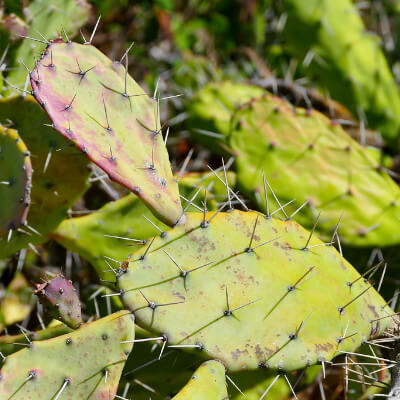
Opuntia monacantha, commonly known as the “Prickly Pear Cactus,” is a fascinating cactus species native to South America. This plant is easily recognised by its flat, paddle-shaped segments that form articulated structures. Its fleshy green stems can grow up to five metres tall, making it both an impressive and decorative addition to any landscape. Its areoles, which bear glochids and sometimes long spines, add a distinctive character to its appearance.
In tropical gardens such as the Au Bois Vert Botanical Garden in Ivato, near Antananarivo, Opuntia monacantha holds a prominent place. This hardy plant thrives in challenging conditions, including arid and rocky soils, and is highly tolerant of hot, dry climates. With its minimal maintenance requirements, it integrates seamlessly into landscape designs, bringing an exotic touch to its surroundings.
The Prickly Pear Cactus produces striking flowers, often in shades of yellow or red, which bloom mainly in spring and summer. These are followed by edible fruits, known as prickly pears, which add vibrant colour and visual appeal to the plant. At the Au Bois Vert Botanical Garden, this species attracts many visitors eager to discover its unique characteristics and ecological role.
Opuntia monacantha also plays a crucial role in preserving local biodiversity. It provides shelter for numerous pollinating insects, making it an essential plant in tropical ecosystems. With its distinctive shape and multiple benefits, this cactus perfectly balances aesthetics and functionality. Hotels, restaurants, and lodges in the region frequently use it to decorate their outdoor spaces, creating a natural and inviting atmosphere.
Plant use
Opuntia monacantha, also known as the prickly pear cactus, plays a significant role in many parts of the world due to its diverse uses. Its fruits, commonly called prickly pears, are rich in nutrients and valued for their sweet yet tangy flavour. These edible fruits are consumed fresh or processed into juices, jams, and desserts. Their high content of vitamin C, vitamin A, and antioxidants makes them a beneficial addition to a healthy diet. Beyond its fruits, the segments of this cactus are widely used in traditional medicine. They possess anti-inflammatory and moisturising properties, often utilised to treat burns, minor wounds, and sunburns. Crushed leaves are sometimes applied directly to the skin or used in the preparation of natural face masks. In agriculture, Opuntia monacantha also serves as a supplementary fodder source for livestock in arid regions. Its fleshy segments provide a water-rich and nutrient-dense food source, helping to sustain animals during drought periods. Moreover, this plant acts as an effective natural barrier thanks to its spines. It is often planted to mark boundaries or to protect crops from animal intrusions. In urban and landscaped environments, it enhances the aesthetic appeal of tropical gardens while requiring minimal maintenance. At Au Bois Vert, Opuntia monacantha exemplifies the balance between functionality and beauty. Its ability to thrive in various environments and offer a wide range of uses makes it a highly valuable plant. Whether enriching a botanical garden, adorning hotels and lodges in Ivato, or being utilised for its practical benefits, the prickly pear cactus remains an ideal choice for nature enthusiasts and sustainability advocates alike.
Key information
| Common name | Prickly Pear Cactus |
| Scientific name | Opuntia monacantha |
| Origin | South America |
| Natural habitat | Arid and semi-arid zones |
| Life cycle | Perennial |
| Flowering period | Spring and summer |


